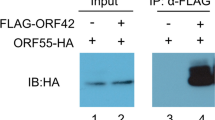Abstract
To purify the protein encoding the small capsid protein (SCP) of KSHV and analyze its immunogenicity, the carboxyl terminus of orf65 of Kaposi’s sarcoma associated-herpesvirus (KSHV) was expressed in a prokaryotic expression system. The expression of recombinant E.coli containing pQE-80L-orf65 was induced by isopropyl-β-D-thiogalactopyranoside (IPTG) and the fusion protein was purified by chromatography. The expressed protein and its purified product were identified by sodium dodecyl sulfate-polyacrylamide gel electrophoresis (SDS-PAGE) and showed that 9 kDa was the expected size of the purified orf65 protein. The antiserum was produced in rabbit which was immunized by purified orf65 protein. An ELISA assay was established to analyze the immunogenicity of the purified orf65 protein. The ELISA analysis demonstrated that orf65 protein has strong immune activity, and the immune activity of polyclonal antibody against orf65 was more than 4 fold higher than that in the serum of the non-immunized rabbit. These results demonstrate that purified orf65 protein has very strong immunogenicity and can be used in screening KSHV infection in the general population using ELISA.
Similar content being viewed by others
References
Belec L, Cancre N, Hallouin M C, et al. 1998. High prevalence in Central Africa of blood donors who are potentially infectious for human herpesvirus 8. Transfusion, 38(8): 771–775.
Cesarman E, Chang Y, Moore P S, et al. 1995. Kaposi’s sarcoma-associated herpesvirus-like DNA sequences in AIDS-related body-cavity-based lymphomas. N Engl J Med, 332(18):1186–1191.
Chang Y, Cesarman E, Pessin M S, et al. 1994. Identification of herpesvirus-like DNA sequences in AIDS-associated Kaposi’s sarcoma. Science, 266(5192): 1865–1869.
Engels E A, Sinclair M D, Biggar R J, et al. 2000. Latent class analysis of human herpesvirus 8 assay performance and infection prevalence in sub-saharan Africa and Malta. Int J Cancer, 88(6): 1003–1008.
Engels E A, Whitby D, Goebel P B, et al. 2000. Identifying human herpesvirus 8 infection: performance characteristics of serologic assays. J Acquir Immune Defic Syndr, 23(4): 346–354.
Fujii T, Taguchi H, Katano H, et al. 1999. Seroprevalence of human herpesvirus 8 in human immuno-deficiency virus 1-positive and human immunodeficiency virus 1-negative populations in Japan. J Med Virol, 57(2): 159–162.
Lin S F, Sun R, Heston L, et al. 1997. Identification, expression, and immunogenicity of Kaposi’s sarcoma-associated herpesvirus-encoded small viral capsid antigen. J Virol, 71(4): 3069–3076.
Melbye M, Cook P M, Hjalgrim H, et al. 1998. Risk factors for Kaposi’s-sarcoma-associated herpesvirus (KSHV/ HHV-8) seropositivity in a cohort of homosexual men, 1981–1996. Int J Cancer, 77(4): 543–548.
Russo J J, Bohenzky R A, Chien M C, et al. 1996. Nucleotide sequence of the Kaposi sarcoma-associated herpesvirus (HHV8). Proc Natl Acad Sci USA, 93(25): 14862–14867.
Schulz T F. 1998. Kaposi’s sarcoma-associated herpesvirus (human herpesvirus-8). J Gen Virol, 79( Pt 7): 1573–1591.
Simpson G R, Schulz T F, Whitby D, et al. 1996. Prevalence of Kaposi’s sarcoma associated herpesvirus infection measured by antibodies to recombinant capsid protein and latent immunofluorescence antigen. Lancet, 348(9035): 1133–1138.
Wang L. 2007. Pathogenesis and associated Diseases of Kaposi’s Sarcoma-associated Herpesvirus. Virol Sin, 22(3): 248–255..
Whitby D, Luppi M, Barozzi P, et al. 1998. Human herpesvirus 8 seroprevalence in blood donors and lymphoma patients from different regions of Italy. J Natl Cancer, Inst90(5): 395–397.
Zeng Y, Zhang X, Huang Z, et al. 2007. Intracellular Tat of human immunodeficiency virus type 1 activates lytic cycle replication of Kaposi’s sarcoma-associated herpes-virus: role of JAK/STAT signaling. J Virol, 81(5): 2401–2417.
Author information
Authors and Affiliations
Corresponding author
Additional information
Foundation items: Supported by the Knowledge Innovation Program of the Chinese Academy of Sciences (0702121Y-J1)
Rights and permissions
About this article
Cite this article
Fu, Bs., Li, Bl. & Wang, Ld. Immunogenicity analysis of prokaryotic expression products of Kaposi’s sarcoma associated herpesvirus orf65. Virol. Sin. 23, 196–202 (2008). https://doi.org/10.1007/s12250-008-2925-z
Received:
Accepted:
Published:
Issue Date:
DOI: https://doi.org/10.1007/s12250-008-2925-z




